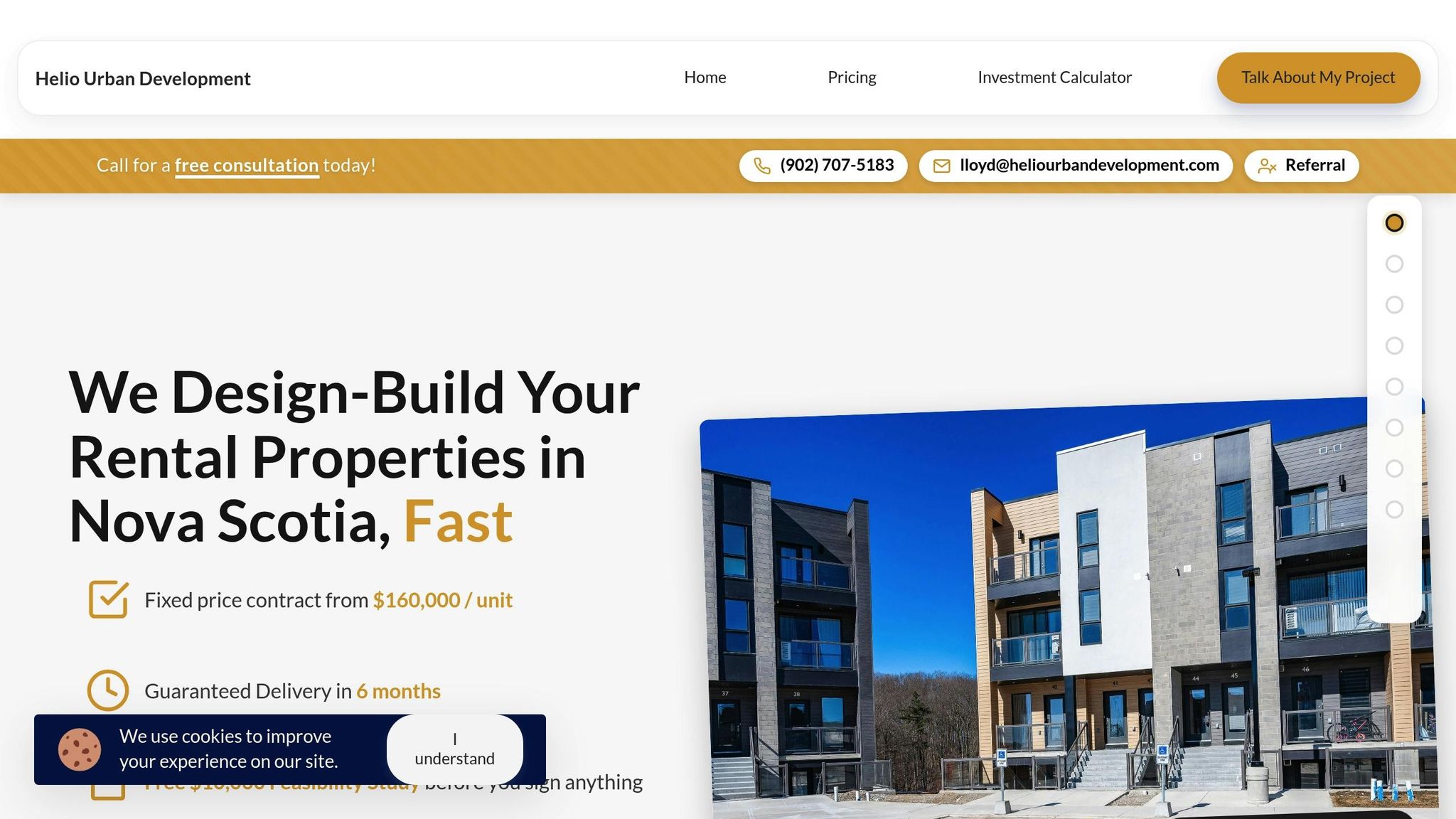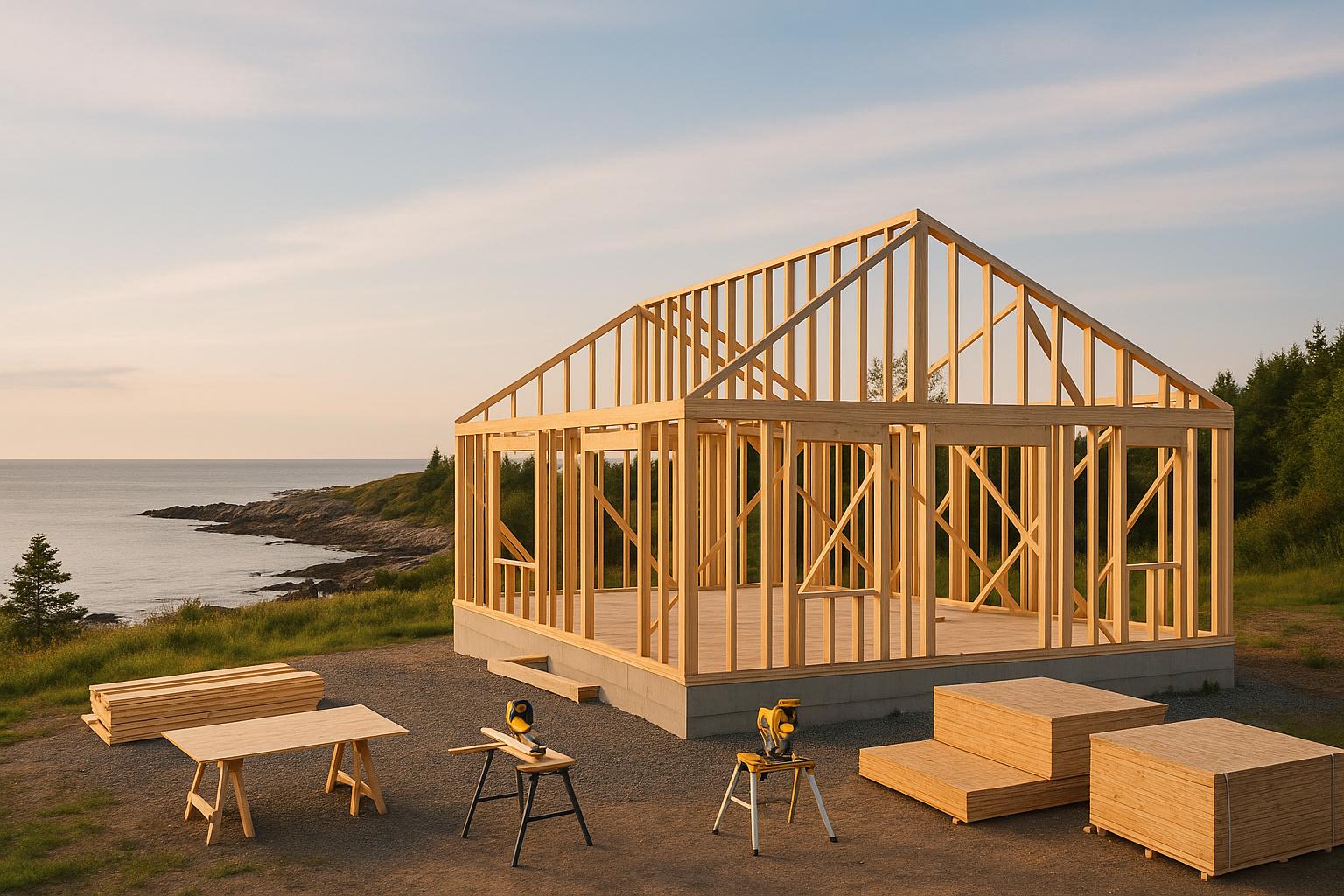Land-use bylaws in Nova Scotia dictate how properties can be developed, covering zoning, setbacks, and other rules under the Municipal Government Act. Each municipality has unique regulations, so what works in one area may not apply elsewhere. For rental property developers, especially those building multi-unit housing, understanding these bylaws is essential to avoid costly delays, redesigns, or legal issues. Key points include:
- Zoning: Determines what can be built (e.g., single-family homes, duplexes, or apartments). Higher-density zones like R-2 or R-3 allow for more units but come with stricter requirements.
- Setbacks: Define the minimum distance buildings must maintain from property lines. Typical setbacks in Nova Scotia range from 6-9 metres at the front to 7.5 metres at the rear.
- Coastal Rules: Municipalities now manage coastal development, enforcing buffer zones and minimum building elevations to address risks like flooding and erosion.
For smoother projects, integrated construction approaches - like those offered by Helio Urban Development - combine planning, design, and building under one team to ensure compliance and faster timelines. Helio guarantees fixed pricing ($160,000/unit) and completion within six months, helping property owners avoid common pitfalls and maximize returns.
How to Quickly Look Up Zoning in Halifax, Nova Scotia
Zoning and Property Line Requirements
Zoning regulations play a key role in shaping your property's development potential and the income it can generate. To succeed as a property owner or developer, it's crucial to understand zoning categories and property boundary rules. These guidelines, based on municipal planning strategies, influence not only the design of your project but also its financial outcomes.
Zoning Categories and Permitted Uses
In Nova Scotia, municipalities use zoning categories to manage development. If you're a rental property owner, you'll frequently encounter Residential (R) zones. Here's a quick breakdown of what they allow:
- R-1: Designed exclusively for single-family homes.
- R-2 and R-3: Allow higher-density housing like duplexes, triplexes, and apartment buildings. These zones can significantly increase your property's rental income potential and overall value [1]. Planning to build a fourplex or larger? Make sure your land is zoned for multi-family use.
Commercial (C) zones tend to offer higher per-square-foot values because of their potential for income through retail spaces or office rentals [1]. Meanwhile, Mixed-Use (MU) zones allow for a combination of residential and commercial development, providing flexibility and the chance to diversify your revenue streams.
Your zoning category directly impacts your property's market value and development options. Higher-density zoning often translates to greater opportunities for rental income [1], so understanding these categories is essential as you plan your project and adhere to setback regulations.
Property Line and Setback Basics
Once you're familiar with your zoning category, the next step is understanding property lines and setback rules. Property lines define the legal boundaries of your land, while setbacks dictate the minimum required distance between your building and these boundaries. These rules are in place to ensure proper spacing for safety, functionality, and neighbourhood consistency.
Zoning categories also come with minimum lot size requirements. For instance, a property zoned for a fourplex will need more square footage than one intended for a single-family home. These requirements ensure that the land can support the planned density without overwhelming local infrastructure.
Building height restrictions often go hand-in-hand with setbacks, further shaping your project's scale. Depending on the zoning, these limits can influence how many rental units you can include in your development.
How Zoning Rules Differ Between Municipalities
Zoning rules aren't one-size-fits-all - they vary significantly between municipalities like Halifax, Lunenburg County, and Dartmouth. For example, Halifax Regional Municipality has its own set of zoning guidelines, which can differ from those in smaller towns. This makes it essential to review local zoning maps and bylaws before buying land or starting any development [1].
For precise zoning information, tools like Halifax's ViewPoint or the Nova Scotia Geomatics Centre can provide property-specific data. These regional differences highlight the importance of localized planning and ensuring your construction approach aligns with municipal regulations.
Setback Rules and How to Follow Them
Setback regulations specify the minimum distance a building must maintain from its property lines. These rules, outlined under the Municipal Government Act, ensure safe spacing between structures, help manage population density, and protect property values [3][1].
Why Setbacks Matter for Multi-Unit Properties
For rental property owners, setbacks are more than just legal requirements - they play a crucial role in maintaining privacy and harmony, especially for multi-unit buildings. By creating a buffer between neighbouring properties, setbacks reduce the likelihood of disputes between tenants and adjacent property owners.
They also contribute to the overall look of a neighbourhood. Buildings placed too close to property lines can create a cramped, overcrowded appearance. Proper setbacks help preserve a more open and appealing aesthetic, which positively impacts property values - not just for your property, but for the entire area [3][1].
From a practical standpoint, adhering to setback rules is essential for maximizing the potential of multi-unit developments. Proper planning allows you to design the largest legal building footprint, ensuring you can include as many rental units as possible while staying compliant with local regulations [1].
How to Measure and Meet Setback Requirements
Setbacks are measured from the closest part of a structure to the property line, including both the front and rear of the building [3]. In Nova Scotia, typical setback distances are:
- Front: 6-9 metres (20-30 feet)
- Rear: 7.5 metres (25 feet)
- Sides: 1.5-3 metres (5-10 feet) [1].
Before starting construction, it’s vital to identify property lines accurately. You can use property deeds, surveys, or plat maps to confirm boundaries [3]. Additionally, tools like Halifax's ViewPoint or the Nova Scotia Geomatics Centre offer detailed zoning and property information to help determine the exact setback requirements for your location [1].
Although minor variations (up to 2%) in dimensions may sometimes be allowed if they don’t compromise safety or accessibility [2], it’s best not to depend on such exceptions. Designing your project to fully comply with zoning laws from the start will help avoid delays or rejections during the approval process [1].
For complex projects, working with experienced professionals is invaluable. Companies like Helio Urban Development are familiar with setback rules across Nova Scotia and can help design projects that meet legal requirements while maximizing rental potential.
What Happens When You Don't Follow Setback Rules
Failing to comply with setback rules can lead to serious consequences, including increased costs and project delays. As Will Van Vactor, J.D., from the University of Utah S.J. Quinney College of Law, explains:
"In some instances, if a house violates a setback, the property owner can legally be forced to move or reconfigure a portion of the house to fix the violation. In most cases, that would be an expensive fix." [4]
Such violations can also make it difficult to sell the property, as potential buyers may be deterred by the risk of future legal or financial complications [4]. Even if your property benefits from "grandfathered" rights under older regulations, any renovations or improvements might require compliance with current setback rules [4].
Ignoring setback requirements can result in permit denials, mandatory alterations, legal disputes, and significant delays - sometimes stretching projects by months or even years [2][3][4]. While it’s possible to apply for a municipal variance to bypass certain zoning rules, this process involves extra costs, time, and uncertainty, with no guarantee of approval [4].
If you’re purchasing a property with existing structures, address any known setback violations before finalizing the deal. This proactive approach can save you from future headaches when it comes time to sell [4].
The best way to avoid these issues is through thorough research and professional assistance. Don’t rely solely on municipal information - verify setback compliance independently, and consider seeking advice from a land use attorney for more complex situations [4].
sbb-itb-16b8a48
Better Ways to Build Rental Properties
Modern construction methods are stepping up to tackle the challenges that traditional approaches often fail to resolve. These older methods can delay projects, inflate costs, and make it tough to navigate bylaws. However, integrated construction approaches offer a more efficient path forward.
Old Construction Methods vs. New Integrated Approaches
Traditional construction often involves hiring multiple professionals for different stages of a project: planners to handle bylaws, architects for design, engineers for structural work, and contractors for building. While this may seem straightforward, it usually results in disjointed communication, as each professional works independently with their own goals and timelines.
The outcome? Projects that frequently run 30-60% over budget and stretch far beyond their original timelines. What begins as an 8-month plan can easily spiral into 18 months or more. Property owners are often left juggling conflicts, delays, and rising costs while their rental income potential is put on hold.
Integrated design-build approaches solve these issues by uniting planners, architects, engineers, and construction teams under one roof. This cohesive system ensures everyone is aligned on key objectives: adhering to bylaws, staying within budget, and finishing on time. By streamlining coordination, integrated methods provide both financial clarity and reliable timelines - advantages that are reshaping the construction landscape.
How Helio Urban Development Helps Property Owners

A standout example of this integrated model is Helio Urban Development, based in Nova Scotia. As the province’s only design-build company focused on 4+ unit rental properties, Helio is rewriting the rules of rental property construction. Founded by Lloyd Liu (a former investment banker from Merrill Lynch with a Yale background) and Yuan He (a data scientist from the University of Pennsylvania), the company emerged from their frustration with the inefficiencies of traditional construction methods.
Helio guarantees fixed-price construction at $160,000 per unit, completed within 6 months. To back this promise, they impose delay penalties of $1,000 per day - offering property owners peace of mind about when they can start earning rental income.
Currently, Helio has 31 units under construction across Nova Scotia, with an additional 131 in the planning stages. They operate within a 90-minute radius of Halifax, providing property owners with a single point of contact for everything: one contract, one timeline, and one team handling permits, bylaws, and construction.
Their process includes daily photo updates, triple P.Eng quality checks, and a 2-year warranty. This means property owners can monitor their projects remotely while Helio’s team takes care of the heavy lifting, from permit applications to bylaw compliance.
Real Benefits for Property Owners
Choosing an integrated construction approach like Helio’s can lead to substantial financial benefits. On average, property owners save $47,000 by avoiding the inefficiencies of coordinating multiple contractors. Fixed pricing removes budget surprises, and guaranteed timelines ensure rental income starts when expected.
With Helio’s 6-month construction guarantee - compared to the industry standard of 12-18 months - property owners can begin earning rental income 6-12 months earlier. Their team also identifies and resolves bylaw and zoning issues during the planning phase, preventing costly delays during construction.
Helio’s bulk purchasing power and streamlined processes further minimize setbacks. Their close relationships with suppliers and municipal offices, paired with a systematic approach to documentation and approvals, eliminate many of the delays that plague traditional projects.
For those seeking financing, Helio offers a CMHC MLI Select construction option at $200,000 per unit. This allows property owners to secure 95% financing with just a 5% down payment and a 50-year amortization period. Combined with guaranteed timelines, this financing model enables property owners to achieve annual returns of 12-20% while maintaining positive cash flow from the start.
Coastal Rules in Nova Scotia
In addition to zoning and setback rules, coastal areas in Nova Scotia bring their own set of challenges and regulations. With its vast coastline, the province faces unique obstacles when it comes to developing rental properties. Recent updates in coastal regulations have moved decision-making from the provincial government to local municipalities, resulting in a variety of approaches across the region. These coastal-specific rules work alongside broader land-use bylaws, significantly influencing how rental property projects are planned.
New Rules for Coastal Development
As of April 15, 2025, the Province of Nova Scotia introduced model municipal bylaws offering municipalities flexible tools to manage coastal development. These bylaws allow for the creation of coastal protection zones, mandate minimum building elevations to reduce flooding risks, and enforce buffer zones to combat erosion risks [5].
This change followed the shelving of the Coastal Protection Act (CPA) on February 26, 2024. Instead of a province-wide framework, the new plan shifted the responsibility for coastal development to municipalities and property owners [6]. This adjustment means that local governments and individual property owners now hold the primary authority for decisions related to coastal properties.
For rental property developers, adhering to these municipal coastal guidelines is crucial to ensure compliance and project success.
Following the Rules and Making Money on Your Investment
Getting familiar with Nova Scotia's land-use bylaws is critical to protecting your investment and boosting your returns. For property owners, understanding zoning laws, setback requirements, and coastal regulations can pave the way to creating profitable rental properties with steady income over time. However, the challenge lies in navigating these rules, which can vary greatly depending on the location.
Municipal regulations across Nova Scotia are far from uniform. What applies in Halifax might not hold true in Antigonish or Bridgewater. This patchwork of rules can be a major hurdle for anyone planning to develop rental properties with four or more units.
When coordination between professionals - like architects, engineers, and planners - breaks down, the results can be costly. Mistakes, regulatory delays, and budget overruns can derail a project, turning what seemed like a sound investment into a financial headache.
This is where integrated construction solutions come in. By bringing all the necessary expertise under one roof, these solutions eliminate the risks of fragmented coordination. One standout example is Helio Urban Development. Their team of planners, architects, engineers, and construction professionals works together to navigate Nova Scotia's often-complicated regulatory environment. This approach has helped many property owners avoid common pitfalls and stay on track.
The financial upside of getting the regulations right is hard to ignore. Builders like Helio deliver rental incomes ranging from $1,950 to $2,100 per unit per month, with annual returns between 12% and 20%. Their fixed-price construction model - set at $160,000 per unit - takes the uncertainty out of budgeting. Compare this to fragmented projects, where cost overruns of 30% to 60% can quickly turn a promising project into a financial burden.
Timelines matter just as much as budgets. Construction delays can eat into potential rental income - around $8,800 per month for a fourplex. Helio tackles this with a 6-month construction guarantee and penalties of up to $1,000 per day for delays, ensuring projects stay on schedule and rental income starts as planned.
FAQs
How do zoning regulations in Nova Scotia impact the rental income and value of a property?
Zoning rules in Nova Scotia, like ER-2, play a big role in determining what can be built on a property, which directly impacts rental income and property value. For instance, areas that allow duplexes or semi-detached homes often provide more rental potential and can boost the property's overall worth. Rezoning to higher-density or mixed-use zones can open the door to even more development possibilities, increasing both income and value.
Knowing the ins and outs of zoning categories and their restrictions helps property owners plan rental projects more effectively. High-density zones, in particular, tend to offer better opportunities for generating profits and achieving long-term growth.
What happens if setback rules are not followed when building multi-unit rental properties in Nova Scotia?
Failing to follow setback rules can result in serious repercussions, like legal disputes, fines, or even orders to alter or move structures. These setbacks can also lead to costly project delays as adjustments are made to align with regulations.
To steer clear of these problems, it's crucial to familiarize yourself with local land-use bylaws and ensure your project meets all setback requirements. Partnering with an experienced team, such as Helio Urban Development, that understands Nova Scotia’s regulations can help you stay compliant while keeping your project on track and within budget.
What do Nova Scotia’s coastal development regulations mean for property owners planning to build rental units near the coast?
Nova Scotia has introduced updated regulations for coastal development aimed at shielding these areas from erosion, flooding, and other challenges linked to climate change. The new rules make it mandatory to obtain permits for construction within specific coastal zones and implement tighter guidelines to protect both ecosystems and infrastructure.
For property owners looking to build rental units near the coast, these regulations might restrict certain types of projects or necessitate modifications to align with environmental standards. While this could add extra steps in the planning process, the goal is to promote the long-term safety and resilience of coastal properties.



